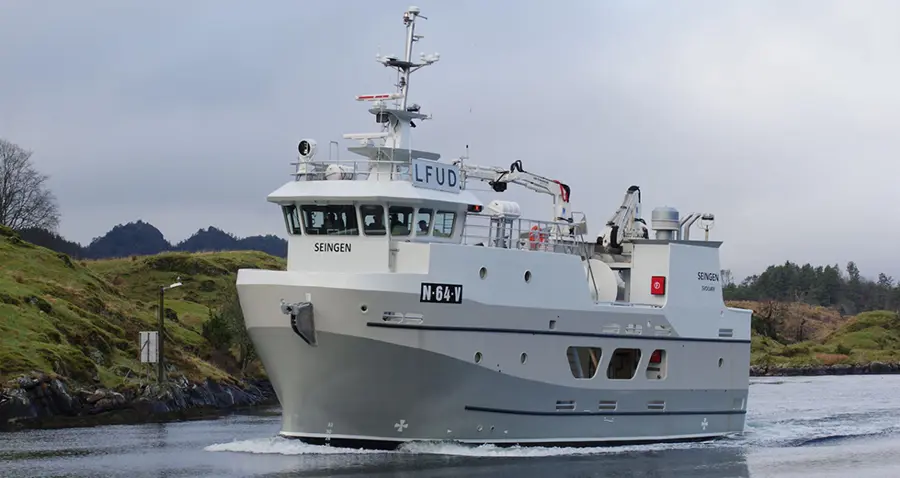

Fishing company Fjordbakk AS in Norway has this year acquired an exciting new fishing vessel Seingen from boat builder Mundal Båt. Mundal Båt has previously supplied larger fishing boats and commercial vessels in composite material.
Seingen is equipped with a Danish seine, a fishing tool that resembles a trawl but is not towed behind the boat, which is more gentle on wildlife in the water. Four people make up the crew. The engine is a 13 litre 500 hp Scania engine and there is a 120m3 load compartment with RSW system (system for efficient cooling of seawater and fish). The boat can transport live fish. The fishing boat is 20.95 metres long and 7.2 metres wide. It is used for white fish such as cod, saithe and haddock. Seingen will primarily be used in the northernmost parts of Norway.
In the fishing industry, there is a strong focus on building boats with the least possible emissions. Battery packs and LNG as fuel sources reduce greenhouse gas emissions. Building the vessel in lightweight materials also affects the boat’s consumption. Hull design and total weight have a decisive influence on the ship’s fuel consumption. Seingen is built in a composite sandwich, which makes it considerably lighter than if it was made of steel or aluminium. The material used is different grades of Divinycell H.
For shipowners, the focus has been on fuel consumption per kilo of fish they supply. When building fishing vessels, the focus is often on energy savings, for example by using batteries, electric winches and other measures to reduce consumption. However, there has been less focus on fuel savings resulting from the use of lightweight construction materials. The fact that the boat is built in a sandwich construction makes it light but also provides better insulation, which means lower energy consumption for cooling the catch and heating the cabins.
Seingen allows fish to be pumped onboard and opens up for delivering live fish. So far, mainly cod that has been delivered live and then stored in cages. Last year, attempts were made to supply live haddock. This was successful and could be a focus area for the boat, which this year has a quota of 1523 tonnes of haddock, 513 tonnes of cod and 342 tonnes of saithe.
Demands for reduced climate emissions and climate-friendly food is increasing internationally. Although many species of fish entail low greenhouse gas emissions per kilo, there is a large difference between species and catching method. If requirements are made for fish to be labelled so that consumers can see how much greenhouse gas emissions the fish accounts for, Seingen will quickly have major benefits.
Operating costs are low on a ship like Seingen. On trips of 8 miles, the boat consumes 38 litres per hour and when you reduce to 7 miles, consumption is reduced to 20 litres. Ten miles at full speed consumes 93 liters of diesel per hour. When it comes to the final accounts, fuel consumption per kilo of fish is what matters. ”We have a workplace that will be good for both the environment and us,” says shipowner Svein Håkon Fjordbakk.
